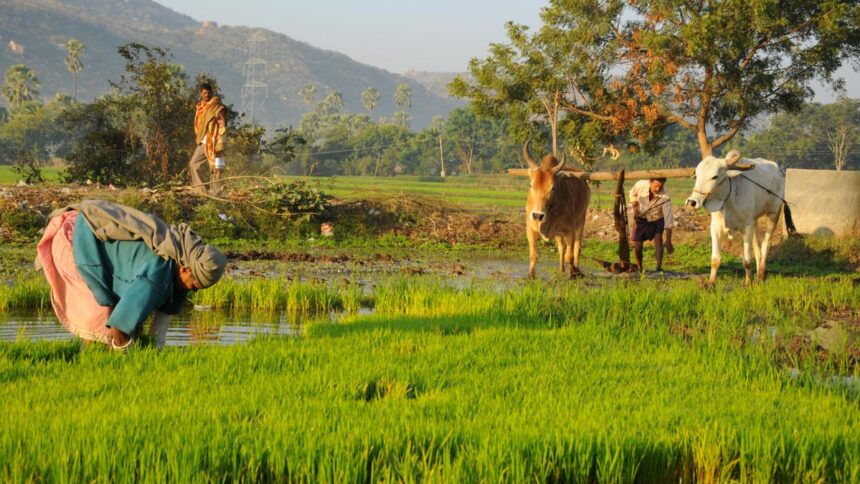
The Andhra Pradesh government had decided not to implement the scheme of the PMFby 2020 scheme, but joined the scheme with effect of the Kharif 2022 season. | Photo credit: Ramakrishna G
Almost a decade after the launch of the Pradhan Mantri Paseal Bima Yojana (PMFby) and the crop insurance scheme based on the restructured climate (RWBCIS), the data show that 97 percent of all the reported claims have resolved Acrross. However, there are gaps in some states/territories of the Union, leaving thousands of farmers waiting for their quotas.
The data presented by the Ministry of Agriculture and Welfare of farmers to Lok Sabha in April 2025 show that Goa, Chhattisgarh, Telangana and Tamil Nadu have reached a total claims agreement under the schemes, reflecting an efficient implementation. In contrast, the Tripura, Andaman and Nicobar, Andhra Pradesh and Sikkim Trail islands at the bottom, with settlement rates ranging from 91 percent to only 51 percent, which increases the CONNS on operating bottlenecks.
Andhra Pradesh has become the state with the largest deficit in crop insurance payments, and farmers are still waiting for claims for the value of ₹ 1,842 million rupees. The Andhra Pradesh government had decided not to implement the scheme of the Kharif 2020 PMFby scheme. He joined the scheme with effect of the Kharif 2022 season. This derailed the entire mechanism. The opposition has also claimed that the government’s delay in paying its part delayed payment to farmers.
Maharashtra continued with ₹ 631 million rupees in pending claims, while Rajasthan occupies the third place with ₹ 478 million rupees still to disburse. Maharashtra farmers, however, have submitted the highest claims under PMFby and RWBCI in the last six years, representing ₹ 33,259 million rupees, which is almost 24 percent of the total claims reported throughout the country. Rajasthan comes next, with ₹ 25,284 million rupees, followed by Madhya Pradesh in ₹ 22,749 million rupees. Karnataka and Tamil Nadu have reported claims worth ₹ 11,346 million rupees and ₹ 9,067 million rupees respectively, which makes them the five main states in terms of insurance claims under the schemes.
Unequal performance
With the value of ₹ 1.38 Lakh Crore in reported claims and ₹ 1.34 Lakh Crore already disbursed, the PMFby and RWBCIS schemes have extended significantly in the last 6 years. However, unequal performance in all states indicates the need for deeper systemic reforms and a stronger responsibility to ensure that each farmer, regardless of how small, can resist the uncertainties of agriculture.
Although the Ministry of Agriculture argues that most claims are resolved within the stipulated deadlines, delays and discrepancies have been found in the implementation of the duration. Issues such as the incorrect or late presentation of insurance proposals by banks, disputes on performance data, delays in the release of funds from the state government and inappropriate personnel by insurance companies for delays or insufficient payments. The authorities said the thesis challenges have been addressed according to the provisions established in the guidelines of the scheme.
Fundamental reality
For farmers in the field, delays mean more than administrative obstacles. Ramesh Shinde, a small Nashik farmer, highlights the precarious situation they face. “The number of statements may seem short in the general scheme, but for small and marginal farmers, even ₹ 100 is a large amount. If claims are not paid for entire seasons, how can a farmer allow the next sowing cycle?” Hello Ash.
Duration of the Kharif 2016 season, PMFBy offers farmers protection against climate -related risks by providing comprehensive risk coverage of the stages after harvest at a minimum premium cost.
The extremely low premium rate is charged with farmers or 2 percent of the sum insured for Kharif crops, the maximum 1.5 percent of the sum secured for Rabi crops and the maximum 5 percent of the sum insured for commercial/horticultural crops. The states such as Odisha, Meghalaya, Jharkhand and UTS such as Pusucherry are paying the participation of farmers in the premium of the people that farmers must pay only ₹ 1. The remaining part of the actuarial premium is shared by the central and state governments in a 50:50 basic, except in the northeastern states (of Kharif 2020) and the Himalayan states (Kharif 2023), where it is shared in the proportion of 90:10.
Posted on May 5, 2025




